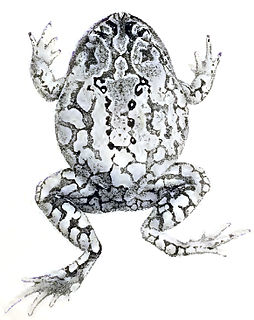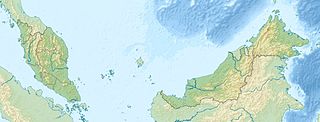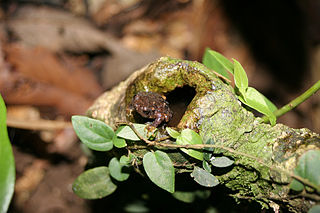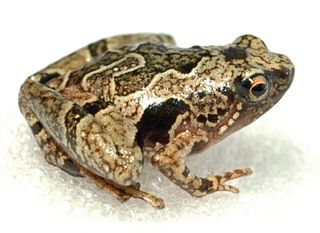
Kalophrynus is a genus of microhylid frogs. It is the only genus in the subfamily Kalophryninae. The species in this genus are found in southern China, in Southeast Asia to Java and Philippines, and in Assam, India.
Ansonia fuliginea, the North Borneo stream toad or North Borneo slender toad, is a species of toad in the family Bufonidae. It is endemic to Mount Kinabalu in Sabah, Malaysian Borneo.

Glyphoglossus brooksii is a species of frog in the family Microhylidae. It is endemic to Borneo and found in Kalimantan (Indonesia) and Sarawak (Malaysia). Its common names are Brooks' squat frog and Brooks' burrowing frog. It is named after Mr. Cecil J. Brooks who collected the holotype "in a hole whilst prospecting" in Bidi, Sarawak.
Glyphoglossus smithi, also known as Smith's squat frog or Smith's burrowing frog, is a species of frog in the family Microhylidae. It is endemic to Sabah and Sarawak in Malaysian Borneo. However, it is likely to occur more widely than currently known and be present in Brunei and Indonesia. The specific name smithi honours Dr Harrison Willard Smith, an American scientist who collected the holotype from the Limbang River district.
Kalophrynus baluensis is a species of frog in the family Microhylidae. It is endemic to Mount Kinabalu in Sabah.

Kalophrynus eok is a species of frog in the family Microhylidae. It is endemic to Borneo and currently only known from its type locality in the Kelabit Highlands of Sarawak, Malaysia, but presumably, it also occurs in the adjacent Kalimantan, Indonesia. The specific name eok is Kelabit for "tiny" and refers to the small size of this species. Common names eok sticky frog and small Bario sticky frog have been coined for it.
Kalophrynus intermedius is a species of frog in the family Microhylidae. It is endemic to Borneo and is found in Brunei, south-central Sarawak (Malaysia), and Kalimantan (Indonesia). Common names intermediate sticky frog, Sarawak grainy frog, and Mengiong sticky frog have been proposed for it.
Kalophrynus menglienicus is a species of frog in the family Microhylidae. It is known from the vicinity of its type locality in Menglian County in southern Yunnnan, China, and from northern Vietnam; it is likely to occur in adjacent Myanmar and northern Laos. Common names Menglien grainy frog, Menglien narrow-mouthed frog, and Menglien dwarf sticky frog have been coined for this species, in reference to the type locality, as is the specific name menglienicus.
Kalophrynus minusculus is a species of frog in the family Microhylidae. It is endemic to Indonesia and occurs on extreme western Java and on the southeastern tip of Sumatra. It is a relatively small frog, as suggested by its specific name minusculus and vernacular names small sticky frog and dwarf sticky frog.
Kalophrynus nubicola is a species of frog in the family Microhylidae. It is endemic to Sarawak in Malaysian Borneo and is only known from the Gunung Mulu National Park. The specific name nubicola means "dwelling in cloud". Common names blue-spotted sticky frog and mossy-forest sticky frog has been coined for this species.
Kalophrynus robinsoni is a species of frog in the family Microhylidae. It is endemic to Pahang in central Peninsular Malaysia. The specific name robinsoni honours Herbert C. Robinson, a British zoologist and ornithologist. This poorly known species has not been reported since 1922.

Metaphrynella sundana is a species of frog in the family Microhylidae. It is endemic to Borneo and found in Brunei, Indonesia, and Malaysia.

Nanohyla petrigena is a species of frog in the family Microhylidae. It is found in northern and central Borneo and in the Sulu Archipelago of the Philippines. The common names pothole narrow-mouthed frog and Kapit rice frog have been coined for the species.
Oreophryne anulata is a species of frog in the family Microhylidae. It is endemic to the Philippines and is known from Mindanao, Biliran, Siargao, and Leyte; it probably occurs in some smaller, intervening islands too. Common names Mindanao cross frog and Davao cross frog have been proposed for it; the latter in apparent reference to its type locality, "Davao", even though it probably is in error.
Limnonectes kenepaiensis is a species of frog in the family Dicroglossidae. It is endemic to western Borneo and occurs in both Kalimantan (Indonesia) and Sarawak (Malaysia), and perhaps in Sabah (Malaysia). Common name Kenepai wart frog has been coined for it. It was first described as subspecies of Limnonectes paramacrodon, which it resembles.
Meristogenys kinabaluensis is a species of frog in the family Ranidae. It is endemic to Borneo and is found in Sabah, Sarawak (Malaysia), and Kalimantan (Indonesia). The specific name refers to its type locality, Mount Kinabalu.

Polypedates otilophus is a species of frog in the family Rhacophoridae. It is endemic to Borneo where it is widespread and found in Brunei, Indonesia, and Malaysia, typically in the lowlands but sometimes as high as 1,100 m (3,600 ft) above sea level. This species has prominent, sharp ridges behind the eye, above the ear, referred to in its names.
Leptomantis gauni is a species of frog in the family Rhacophoridae. It is endemic to Borneo and is found in Sabah and central Sarawak (Malaysia), Brunei, and north-eastern Kalimantan (Indonesia). The specific name gauni honours Gaun Sureng, a collector for the Sarawak Museum and a companion to Robert F. Inger on field trips when this species was observed. Common names short-nosed tree frog and Inger's flying frog have been coined for it.
Leptomantis rufipes is a species of frog in the family Rhacophoridae. It is endemic to Borneo and known from isolated locations in south-central Sarawak and eastern Sabah and central Kalimantan (Indonesia). Common names Malaysian flying frog and red-legged frog have been coined for this species. The specific name rufipes refers to the red webbing of this frog.

Kalophrynus yongi is a species of frog in the family Microhylidae, also known as the Cameron Highland sticky frog. It is endemic to Peninsular Malaysia and is only known from its type locality near the top of Gunung Brinchang, in the Cameron Highlands, Pahang state. The specific name yongi honours Dr. Yong Hoi-Sen, a zoologist from the University of Malaya.






